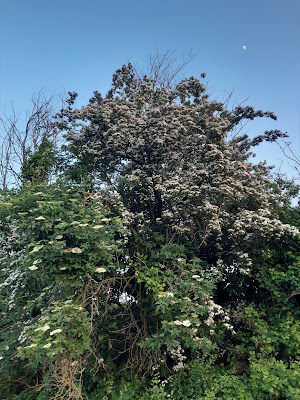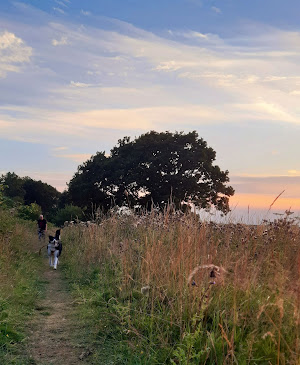The extremes of weather, both last year and this, have made for some confusion. The whitehorn blossom was still fabulous for a few days after I last blogged in late May ...
... although it wasn't long before the petals started falling.
... but soon coming spectacularly into its own. Not sure exactly what happened last summer and this spring to make the blossom so wild, but it was.
Also around the same time, crab apple blossom still going strong ...
... and dogwood. I tend to notice this tree later in the year - the colour of its berries and leaves in autumn, its stems in winter - and the fact this was the first time I'd properly taken stock of its blossom must mean that it too was trying very very hard in a rather less showy way.
These are the heights then, and in order to have heights, there must also be lows. One of these was coming back from holiday while the ground was still very dry to find a barbeque or camp fire had burnt part of the field.
There was also a pile of burnt charcoal close to the oak tree, along with a used disposable BBQ, four plastic drinks bottles, a burnt
miniature glass bottle of spirits, a burnt tennis ball, and a pair of men's droopy grey underpants. Fortunately, the revellers had also left behind a
carrier bag, which was empty apart from some unused firewood and a golf ball, so I had something to carry it all away in.
Another low - a far more worrying one - is climate change. I'm an unreliable narrator, always spotting
new-to-me creatures and flowers and laboriously identifying them, only to glance
at my Facebook memories or past blogs and realise I identified exactly the same last year ... and sometimes the
year before too. As my memory's that spotty, I clearly can't conclude with any certainty whether there are fewer insects about this year, as
everyone seems to be saying, though it feels like there are.
If this is the case, is it the same combination of unusual weather conditions that could have caused the extraordinary displays of blossom, that might be responsible for this dearth of invertebrates - if there is one?
To further complicate matters, the fields beyond Charlton Common, which are undergoing development, were once again mowed at a critical time for wildlife, including insects. Here's what they looked like in late May ...
Above is a contingent of non-pea-based, it's-not-yet-midsummer-and-the-warmth-and-light-will-last-forever flowers: cut-leaved cranesbill, wild salsify (flower and seedhead), dog roses, buttercup, white clover, woody nightshade, creeping ivy and cinquefoil, moon daisies, camomile, bird's foot trefoil (below), Cwtch in red clover, hedge woundwort, honeysuckle, cat's ear
Here's some I did manage to capture:
Moths TOP: 1. Mother Shipton, a long way from Yorkshire 2. Caterpillar of the Oak Eggar moth BOTTOM: 3. Caterpillar of the Cinnabar moth on ragwort 4. I spotted this cinnabar moth upside down under a
bramble, so I picked it up and put it the right way up on a leaf, whereupon it
immediately tipped over again onto its back. (But what a lovely red flannel
shift!) So I turned it over again and retreated quickly, worrying I might have
disturbed a peaceful scene of dying in the shade and made things worse for the
moth, but its legs had been kicking so maybe not, who knows.
From being busy and noisy throughout spring, the rookery is now silent and more or less deserted, the rooks and jackdaws having fledged their young and moved out onto the fields, which is where we encountered this fledgling crow at the end of May, hunkered down in the grass and under observation by two crows in a nearby tree.
... just as the shiny nature of this little turd suggests there's an insect-eating hedgehog about, not that I've seen one.
... and here's what greeted me on the first day of June.
At least this year the hay was baled and taken away, presumably to be used for fodder.
I consoled myself with the thought that at least the skylarks field, which has already been scalped twice this year, was beginning to recover and has looked especially beautiful in the setting sun, with its silver grasses and pools of tufted vetch. I'd even heard skylarks singing above it again ...
... but by the beginning of this month, the same fate had befallen it.
At the end of the field nearest the road, some of the growth lining the footpath has been left ...
... but down the far end, there's only the path to be seen. I'm now hoping the vetch that's left will be ignored long enough to set seed so I can gather some.
'Reckon they mean it this time,' a passing dog-walker said to me. 'Reckon they do,' I replied.
And to underline her point, the building of houses just around the corner, on a piece of cleared edgelands alongside the air field continues, even on Sunday mornings, the sound of a pneumatic drill a frequent accompaniment to our walks.
Meanwhile, the shifting about of earth on the golf course continues. One evening I squeezed through the fence surrounding the smaller pond to see what they've done to it. Lots of whitethorns gone, the path around it gone, the reed beds gone, the banks covered in wild flowers gone, and I don't know why.
As for the big, shallow pond that was little more
than a slightly damp bog in the summer and filled with an amazing diversity of
flowers, it's impossible to guess even what they're doing with it as it's still completely fenced off.
There's one area where flowers are permitted to thrive unthreatened by development, and that's in the Field of Hollowing Oak and the Small Dark Wood of the Mind. Amongst my favourites are the vetches, and each year I seem to see more and more varieties.
TOP: 1. Common vetch 2. Common vetch, pignut and buttercup 3a. Meadow vetchling 3b. Grass vetchling 4. Tufted vetch and horseshoe vetch BOTTOM: 5. Tufted vetch and bindweed 6. Tufted vetch and agrimony like fizzling rockets 7. Tufted vetch and sorrel 8. More Tufted vetch. Because I like it.
Below, the oh-god-winter-is-coming variety: lady's bedstraw, St John's wort, great willowherb, ragwort, cinquefoil and selfheal, creeping thistle (with small skipper), rosebay willowherb, meadowsweet mown down in the skylark's field before it could even set seed, betony (below), burnet saxifrage, knapweed (below), Cwth in white yarrow, pink yarrow, meadow bindweed
Now, about those insects. I seem to have spotted a fair range but mostly things that won’t keep still for me to photograph them. Earlier in the
year the orange-tipped butterflies were being particularly pesky. During this last week a comma butterfly buzzed
me and disappeared, a Southern Hawker dragonfly zoomed over my shoulder, and a couple of days ago, I saw a Red Admiral and another dragonfly, but both did a bunk upon
seeing me first.
Here's some I did manage to capture:
Butterflies TOP: 1a. Large skipper 1b. Small skipper 2. Marbled white 3.Speckled wood 4a & 4b. Gatekeeper BOTTOM: 5. Ringlet with a damaged wing 6a & b. Meadow brown 7a. Over-exposed white butterfly 7b. Small heath 8. Small tortoiseshell (which happens to be my favourite).
Bees CLOCKWISE from left: 1. Common Carder bumble bee on tufted vetch 2. Red-tailed bumblebee on creeping thistle 3. Buff-tailed bumblebee trapeze artist 4. Honey bee 5. Dark honey bee 6. Poor dark honey bee being devoured by a crab spider
There's always a drama going on at knee-level.
Beetles and flies TOP: 1. Beetle Cantharis nigricans 2. Flying ant 3a. Male thick-thighed beetle on wild salsify 3b. Female thick-thighed beetle (distinguished from male by lack of thick thighs) 4. Azure damselfly BOTTOM: 5. This hogweed is host to eleven parasitoid wasps 6. A ladybird little bigger than a hogweed seed 7. Narcissus bulb fly 8. Red soldier beetles
As far as the red soldier beetles are concerned, I was thrilled to see them turn up bang on time on 1st July, but after a week there were hardly any more of them, and they weren't doing that much copulating either, which is strange ...
... except that when you look around the field, there is hardly any hogweed in flower, which is also strange because normally it carries on till October.
They also particularly like wild carrot (as do I). Sadly, after a false start in late May, when I spotted the familiar scaffolding of a flower, I haven't seen a single carrot up the field or on the footpath through the skylark's field.
I suppose it could be that the unusually hot and dry May and June we've just had has delayed them, and that the flowers will flourish now the rain has returned, but the red soldier beetles are visible for just a month and a later blooming might be too late for them.
The shorn fields have made it easier to see some creatures. What were no more than ears sticking out of grass a few weeks ago were very visible against the sere stubble of the fields by the beginning of June.
When we saw him again the following evening, he looked a lot more feisty.
Starlings were one species I hadn't seen in the edgelands before, although I'd found one of their feathers back in April. This little lot fizzling about the fields soon confirmed their presence ...
... just as the shiny nature of this little turd suggests there's an insect-eating hedgehog about, not that I've seen one.
One of the best encounters, and also the saddest, involve foxes. First there was this beauty in the middle of the lane called Charlton Common, who nipped off onto the bit of wasteland by the bus stop and its goat willow, and who I glimpsed through gap in bushes. I don't think I've ever seen a finer, redder fox ...
Three days later, the fox had definitely taken its place in the circle of life, which is something of a comfort.
... or a sorrier one than this, running, perhaps, when he died. It was on the fields away from the road, no more than four days dead. Maybe a dog got him - you see some scary-looking ones there occasionally - or maybe it had an illness like mange, but it's hard to tell because of the decomposition. Or maybe it just died.
One of the best five minutes of 2022 was spent sitting in the field watching the sun set on Midsummer Day. This year we were in West Wales for the longest day, but all the same, we've seen some beautiful sunsets up the field this year too.










































.jpg)









No comments:
Post a Comment